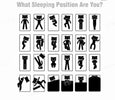
Sleep Positions
, by Lalit Gupta, 3 min reading time

, by Lalit Gupta, 3 min reading time
SLEEP POSITIONS
There are three main sleeping positions with variables of each: side, back, and stomach. Sleep specialists recommend sleeping on your side in order to rest more comfortably and decrease the likelihood of interrupted sleep. While there are many variations of sleeping on your side, all of which are beneficial in helping to alleviate insomnia and chronic sleep deprivation, the most comfortable position involves bending the knees slightly upwards towards the chest area. For those with a bad back, consider placing a pillow between your legs to alleviate pressure on your hips and lower back. Sleeping on your side is actually encouraged for those suffering from back or hip pain or pregnant women since this position doesn’t increase pain in these areas.
If you prefer to sleep on your back, be careful as it may actually induce lower back pain and even episodes of apnea that interfere with normal sleep and restfulness. However, if you prefer to sleep on your back, there are a few minor alterations to this position that you can do to help sleep more soundly. Try placing a soft pillow or rolled-up towel under your knees to facilitate the natural curve of the spine.
If you like sleeping on your stomach, you’re in for a bit of bad news…sleep professionals don’t recommend sleeping on your stomach as it causes strain on your lower back and possible neck pain. People who sleep on their stomach report increased restlessness caused by a frequent tossing and turning in an effort to get comfortable. If you do sleep on your stomach use an extremely soft pillow or none at all so as not to put your neck at an awkward angle. For those with sleep problems, to begin with, it’s best not to sleep on your stomach.
Fetus position – A whopping 41% of participants sleep in this curled-up manner. Women are twice as likely to rest like this and it is listed as the most common position. These sleepers are said to have a tough exterior but are still sensitive and may appear to be shy but warm up quickly.
Log position – If you sleep on your side with both arms down, you are a social, easy-going person who is trusting, sometimes to the point of being gullible. The study showed 15% of people sleep like a log.
Yearner position – A close third is a side-lying position with both arms out in front of the body, with 13% of participants
Sleeping like this. Yearners are noted to be open-minded and still cynical, suspicious, and stubborn about sticking to decisions once they are made.
Soldier position – These sleepers lie on their backs with arms down and kept close to the body. This 8% study is said to be reserved, quiet, without fuss, and hold themselves and others to a high standard. Soldier sleepers have a higher likelihood of snoring due to the flat-back position, which may not cause them to wake up often but may result in a less restful night’s sleep.
Freefall position – Those people who lie on their bellies with arms under or wrapped around a pillow with head turned to the side,
Makeup
7% of the population studied. Freefallers are brash, outgoing, and are very uncomfortable with criticism.
Starfish position – Sleepers who lie on their backs with arms up near their head or the pillow account for 5% of participants. These people are good listeners, helpful, and are uncomfortable being the
Center
of attention. People who sleep in starfish positions are more likely to snore and to suffer from a poor night’s sleep more often.